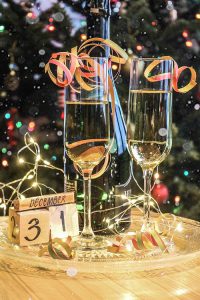HAPPY HOLIDAYS

HOLIDAY HUMANS

Here in the U.S., we call him Santa Claus , but he has other names around the world. In German, he’s called Kriss Kringle , in the Netherlands Sinter Klaas , and in England he’s Father Christmas . In Italy he’s Le Befana, the French call him Père Noël , in Russia he’s Deushka Moroz , and in Norway they call him Julenisse . And there’s more, of course, than what we call things.
Wherever we are in the world, we spend the holiday season according to our own cultural and family traditions. Some are recognizable versions of our own, others less familiar.
Some are remnants of ancient folklore, like in Norway where people hide their brooms on Christmas Eve so the evil spirits can’t find them to ride on and cause havoc. In the Philippines children will polish their shoes on Christmas Eve and leave them on window sills, hoping they will be filled with presents and treats during the night. French and Dutch kids put their shoes by the front door or chimney for the same reason. In Switzerland, look out for Schmutzli – the ‘anti-Santa’ — who, with a whip and an empty present sack, would set out to deter children from being naughty. A similar figure is the Austrian Krampus, once said to capture the naughtiest children and whisk them away in his sack. Fortunately, today these characters are recreated in a more playful way.
The Jewish Hanukkah, or Festival of Lights, is celebrated by friends and families all over the world with traditional foods, music and dance, games and gifts. Central to the holiday celebration is the lighting of the menorah. On each of the holiday’s eight nights, a candle is added to the menorah after sundown; the ninth candle, the Shamash, is used to light the others. Typically, the menorah sits prominently in a window, visible to passersby.
Kwanza, the name derived from the Swahili phrase matunda ya kwanza, meaning ‘first fruits’, is an annual celebration of African-American culture and community held between December 26 and January 1. Similar to the menorah, the kinara is at the heart of Kwanza. Each night one candle is lit, seven in total to represent the seven principles of the tradition.
Of course, there are many other holiday traditions in cultures and faiths across the globe, all of them a reflection of the diversity that makes our world so rich and interesting, many of them deeply rooted in ancient practices.
Now, the challenges of 2020 have led many to create new ways to enjoy the holiday season. A whole range of traditions are being dreamt up and embraced – from Zoom parties and internet cook-offs, to socially distanced sing-alongs and sending e-cards. But no matter where you are in the world, the holiday season is a time for celebration. Even, maybe especially, in 2020.
HIGHLIGHT
NEW YEAR’S EVE

Gourmet Take Out
With Chef Joseph Cizynski
Curbside pick up between 3-4pm
Menu:
Smoked and pickled fish from Poland
France Reveillon de Saint-Sylvester (blinis with foie gras)
Italy Cotechino e lenticche. (garlic sausage with lentil stew)
For the next day- a Hoppin’ John (black eyed pea stew) that will fix your New Year’s Day hangover
$35 Members, $40 Non-Members

Please note the Cultural Center will be closed for two weeks starting this Sunday, December 20th, and will reopen to the public on January 5th with our 2021 Members’ Show .
2020 has been a hectic year for all of us and the team will be getting some much needed R&R before popping back into action like the cork from our “goodbye 2020” bottle of bubbly.
Members! Please remember that all artwork for the Member’s Show must be dropped off between 10am – 5pm on Monday, January 4.
Next week’s MUSE will be all about our education department led by Amy Neill and will highlight what 2021 will bring to YOU!
Happy Holidays from your Cultural Center team!
Bob, Lauren, Amy, Meg, Laura, Becky, and Molly